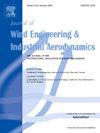The application of the quasi-steady vector model to low-rise buildings with sloped roofs
IF 4.2
2区 工程技术
Q1 ENGINEERING, CIVIL
Journal of Wind Engineering and Industrial Aerodynamics
Pub Date : 2025-02-19
DOI:10.1016/j.jweia.2025.106056
引用次数: 0
Abstract
This paper examines the performance of the quasi steady (QS) vector models on low-rise building roofs of different shapes and slopes. Wind tunnel tests were conducted for low-rise building models with gable and hip roofs of different slopes and compared with data from a flat roof building, for which the QS vector model is known to be accurate. It is observed that the performance of the QS vector model for sloped roofs on low-rise buildings depends on the details of the local flow field and aerodynamics. These models have good accuracy for regions with flow separation but are much less accurate for regions with attached or reattached flow. For regions on sloped roofs with flow separations, the QS vector model is less accurate than for the equivalent separated flow (leading edge) regions on flat roofs when there is separation at the eaves but has a similar level of performance when there is no leading edge separation on the windward roof prior to the separation at the ridge. This is because the separated flow over the leeward portions of the gable and hip roofs is disrupted by the developing windward roof boundary layers when the flow separates at the eaves. Velocity measurements positioned one roof height above the ridge are effective to conduct quasi-steady analysis for the leeward faces of gable and hip roofs where flow separation controls the local aerodynamics. This single probe location is less effective for windward roof faces, which would require different methods to capture the QS fluctuations associated with the developing roof boundary layers.
准稳态矢量模型在倾斜屋面低层建筑中的应用
本文研究了拟稳定向量模型在不同形状和坡度的低层建筑屋顶上的性能。对不同坡度的山墙和臀形屋面低层建筑模型进行了风洞试验,并与平顶建筑的数据进行了比较,证实了QS矢量模型的准确性。研究发现,QS矢量模型对低层建筑坡屋顶的性能取决于局部流场和空气动力学的细节。这些模型对于有流动分离的区域有很好的精度,但对于有附著流或再附著流的区域精度要低得多。对于有流动分离的坡屋顶区域,QS矢量模型在屋檐处存在分离时的精度低于平屋顶等效分离流(前缘)区域,但在脊处分离前迎风屋顶没有前缘分离时,其性能水平相似。这是因为当流动在屋檐处分离时,山形屋顶和斜屋顶背风部分的分离流动被正在发展的迎风屋顶边界层打断。位于屋脊上方一个屋顶高度的速度测量对于山形屋顶和臀形屋顶的背风面进行准稳定分析是有效的,在那里流动分离控制着局部空气动力学。这种单一的探头位置对于迎风的顶板面不太有效,这将需要不同的方法来捕获与发展的顶板边界层相关的QS波动。
本文章由计算机程序翻译,如有差异,请以英文原文为准。
求助全文
约1分钟内获得全文
求助全文
来源期刊
CiteScore
8.90
自引率
22.90%
发文量
306
审稿时长
4.4 months
期刊介绍:
The objective of the journal is to provide a means for the publication and interchange of information, on an international basis, on all those aspects of wind engineering that are included in the activities of the International Association for Wind Engineering http://www.iawe.org/. These are: social and economic impact of wind effects; wind characteristics and structure, local wind environments, wind loads and structural response, diffusion, pollutant dispersion and matter transport, wind effects on building heat loss and ventilation, wind effects on transport systems, aerodynamic aspects of wind energy generation, and codification of wind effects.
Papers on these subjects describing full-scale measurements, wind-tunnel simulation studies, computational or theoretical methods are published, as well as papers dealing with the development of techniques and apparatus for wind engineering experiments.

 求助内容:
求助内容: 应助结果提醒方式:
应助结果提醒方式:


